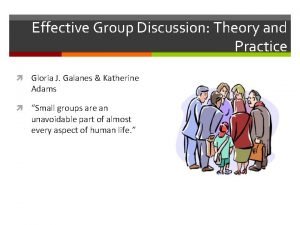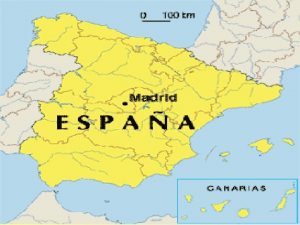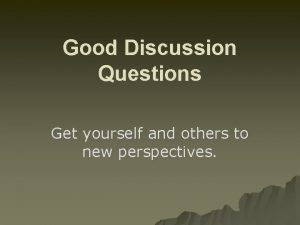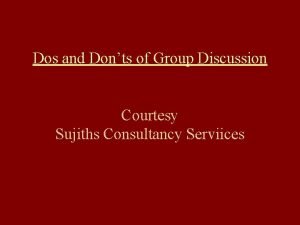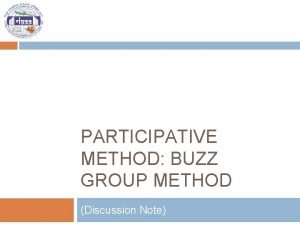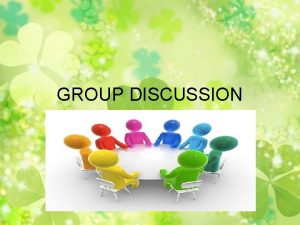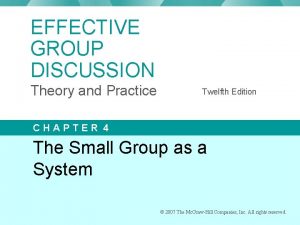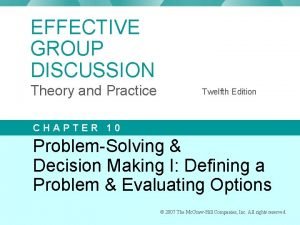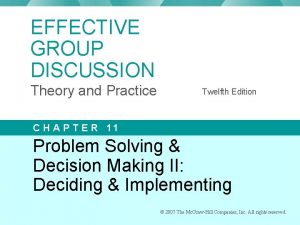Effective Group Discussion Theory and Practice Gloria J













- Slides: 13

Effective Group Discussion: Theory and Practice Gloria J. Galanes & Katherine Adams “Small groups are an unavoidable part of almost every aspect of human life. ”

Four Important Ideas About Groups 1. Groups exist to meet important human needs 2. The formation of groups is natural to humans, thus groups are everywhere. 3. Just because we participate in groups, we cannot assume we participate effectively. 4. Groups provide the vehicle by which the individual can make a contribution to the organization and the society as a whole.

What is a Group? Definition “Three or more people with an interdependent goal who interact and influence each other. ” Most important characteristics: interaction and mutual influence. Example

The Interdependent Goal of a Group Interdependence exissts when all group members succeed or fail together. “An objective shared by members of a small group in such a way that one member cannot achieve the goal without the other members also achieving. ”

What is a Small Group? “A group small enough that each member is aware of and able to recall each other group member, know who is and is not in the group, and recognize what role each is taking. ” Each member is perceived as an individual, the group shares some identity or common purpose, and they share standards for governing their activities as members. There is a sense of belonging.

The 6 Types of Small Groups 1. Primary Groups “A group whose main purpose is to meet members’ needs for inclusion and affection. Nuclear family, roommates, close friends, etc. 2. Secondary Groups “A group whose major purpose is to complete a task, such as making a decision, solving a problem, writing a report, or providing recommendations to a parent organization. ”

3. Activity Groups • “A group formed primarily for members to participate in an activity such as bowling, hunting, and so forth. ” 4. Personal Growth Groups “A group of people who come together to develop personal insights, overcome personality problems, and grow personally through feedback and support of others. ”

5. Educational Groups “A group discussing for the purpose of learning about and understanding a subject more completely. ” 6. Problem-Solving Groups “A group whose purpose is finding ways to solve a problem or address a particular condition. ”

1. Members should be willing to speak and should not do anything to prevent others from speaking freely. 1. Group members should embrace diversity within the group. 1. Group members must conduct themselves with honesty and integrity. 1. Group members should not disconfirm, belittle, or ridicule other members and should make sure they understand members before agreeing or disagreeing with them. 1. Group members should be thorough in gathering information and diligent in evaluating it. 5 Ethical Behaviors of Group Members

What is Communication? “A process in which messages produced by people are received, interpreted, and responded to by other people. ”

Principles of Communication 1. Human Communication is symbolic. 2. Communication is personal. 3. Communication is a transactional process. 4. Communication is not always intentional. 5. Communication involves content and relationship dimensions.

1. I understand communication. I’ve been communicating all my life! 2. All human problems are communication problems. 3. If communicators use good communication techniques, they will automatically have good communication. 4. I didn’t misunderstand him, he misunderstood me. 5. Good communication achieves perfect understanding among participants. Myths about Communication

REFERENCE Galanes, G. J. & Adams, K. (2007). Effective group discussion: Theory and Practice (12 th ed. ). Boston: Mc. Graw Hill.
 Effective group discussion defines human communication as
Effective group discussion defines human communication as Perdoai me outra vez senhor
Perdoai me outra vez senhor Cantemos glória glória a deus nas alturas
Cantemos glória glória a deus nas alturas Gloria gloria corona de la patria
Gloria gloria corona de la patria Effective group discussion
Effective group discussion Fractional distillation discussion
Fractional distillation discussion Joining together group theory and group skills
Joining together group theory and group skills Effective discussion questions
Effective discussion questions Effective teaching evidence and practice
Effective teaching evidence and practice Dos and don'ts of group discussion
Dos and don'ts of group discussion Speaking and listening: effective group discussions
Speaking and listening: effective group discussions Principles of effective practice
Principles of effective practice Www.managementstudyguide.com
Www.managementstudyguide.com Buzz group discussion
Buzz group discussion
